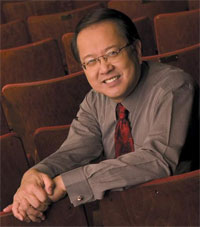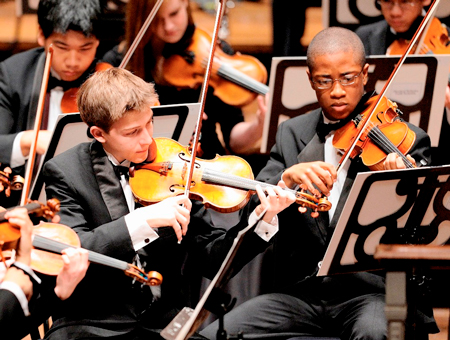by Mike Telin

On Sunday, May 8 at 3:00 pm at Severance Hall, the Cleveland Orchestra Youth Orchestra will present the concluding concert of its 30th-anniversary season under the direction of current music director Brett Mitchell. The program will include Adam Schoenberg’s Finding Rothko, Sergei Rachmaninoff’s Symphonic Dances, and Erich Korngold’s Violin Concerto, featuring COYO concerto competition winner Jieming Tang.
Jahja Ling has enjoyed a long relationship with The Cleveland Orchestra. He served as Associate Conductor during the 1984-85 season, Resident Conductor for 17 years from 1985-2002, and as Blossom Festival Director for 6 seasons (2000-05). But one of his most treasured accomplishments is having created the Cleveland Orchestra Youth Orchestra.
Ling is now in his 12th season as Music Director of the San Diego Symphony Orchestra. He recalled during a telephone conversation how he first came into contact with The Cleveland Orchestra.
“In October of 1983, Christoph von Dohnányi was guest conducting San Francisco Opera. We were introduced and he told me that he was looking for a resident conductor in Cleveland. Could he see me conduct? At the time I was on the conducting staff of the San Francisco Symphony, but since it was the beginning of the season, I was not scheduled to conduct any concerts with the symphony. I told him I only had a rehearsal with the San Francisco Symphony Youth Orchestra, but he said he wanted to come.”
Dohnányi attended a rehearsal of the final movement of Beethoven’s Sixth Symphony and was taken by what he had heard. “I knew that he was sitting at the back of the hall,” Ling said, “but ten minutes later when I looked, he had disappeared. He left so fast, I thought he didn’t like it. But he was impressed with the sound I was creating, so he offered me the job as Associate Conductor in Cleveland. Later he told me that he thought, ‘Wow, that’s a lot of young people onstage wearing blue jeans — they should be called the Blue Jean Philharmonic.’”
Although Ling didn’t know it at the time, after Dohnányi heard the Youth Orchestra in San Francisco, he had a conversation with Kenneth Haas, then-Executive Director of TCO, about creating one in Cleveland. “They worked quietly behind the scenes for two years, and by 1986 they had everything in place. The first manager was Lauren Generette, who returned to that job a few years ago. We worked together and built the orchestra from the ground up.”

Ling went on to explain that model: all of the rehearsals were to be on the stage of Severance Hall; there would be one-hour sectionals each week with the principals of TCO prior to the full rehearsal; the concerts would be held in the main hall, and would receive the same publicity and marketing that TCO did, including live broadcasts on WCLV.
Soon, run-out concerts to surrounding communities were scheduled prior to the Severance Hall performances. Later, tours to places such as New York’s Carnegie Hall, Europe, and most recently China were added. “It’s so wonderful to see how things have developed,” Ling said.
One of Ling’s favorite things is seeing former COYO members who are now members of The Cleveland Orchestra. Those include violist Eliesha Nelson, violinists Alexandra Preucil and Jeffrey Zehngut, and assistant principal trumpet Lyle Steelman. “In San Diego I have many musicians who are former members of both youth orchestras. Last year I was in the lobby at Juilliard and a guy came up and asked if I was Mr. Ling. He said that he was a former COYO member and just wanted to say thanks, because it was so inspirational to him. It makes you feel like you have done something worthwhile for these people. It’s a privilege for me to have had these opportunities.”
Another COYO alum is cellist Alisa Weilerstein, who recently performed the Brahms Double Concerto with San Diego under Ling. “She was very young when she was in the youth orchestra, but when she came to San Diego, she told everyone how much I had inspired her when we played Sibelius’ First Symphony. She remembered everything I had said, like ‘This is the sun coming up.’ And that was 20 years ago.”
Ling said that when you are a staff conductor of a major orchestra, having a youth orchestra is a bonus. “I learned so much from conducting them. I had the experience of learning pieces, coaching the young players, and passing on the traditions.”
Like Christoph von Dohnányi, the late Kurt Masur also first came to know Jahja Ling when he was conducting the SFSYO. “He too was taken by what he heard, and invited me to conduct the Leipzig Gewandhaus Orchestra. He also gave me the opportunity to conduct the New York Philharmonic. And at my invitation, he came to work with both SFSYO and COYO in rehearsals. So it’s not only how much I gave to the youth orchestras, but how much the youth orchestras gave to me.”
Concluding our conversation, Ling said that building a youth orchestra is all about teamwork. “The TCO members who have served as coaches over the past 30 years have been so dedicated. Then there is the management team, the board, and the parents, who have a special devotion and dedication, as does Lauren Generette. She loves those kids.”
Ling’s recent interview with Robert Conrad with be the intermission feature during the Sunday, May 8 broadcast on WCLV, 104.9 FM and wclv.com.
Published on ClevelandClassical.com May 4, 2016.
Click here for a printable copy of this article




